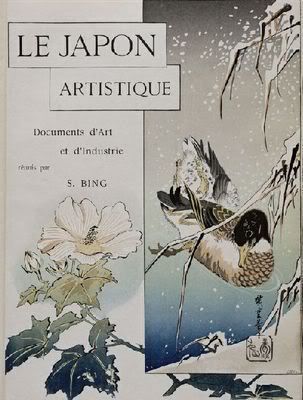
A while ago I posted a picture of the needlepoint project I'm working on that's based on William Morris' Trellis wallpaper pattern. I commented on how much it reminded me of Japanese art. Several of you, who clearly know much more about the subject than I could pretend to, pointed out that the Arts and Crafts movement was heavily influenced by Japanese art.
Well, it turns out the knife cuts both ways! Apparently, William Morris was a huge hit in Japan. 316 studies on Morris were published there between 1891 and 1975, the majority of which were written before the outbreak of the Second World War (Nakayama, 273). Early interest in Morris’ writings primarily had to do with his social thought, which was described in Japanese as “artistic socialism” (274). The 1930s were the golden decade for Morris studies in Japan. In 1934 as a celebration of the hundredth anniversary of his birth, an exhibition of the works of William Morris was held in Maruzen, Tokyo for the first time. Sadly, little of his art was available for display, save the Kelmscott Chaucer, which was described in the exhibition guide as “a rare book worthy of being called a national guest”(274).
One leading Japanese thinker chose to expand research on Morris’ philosophy to include education. Educationist Tatsuo Morito praised Morris’ views on education, using Morris’ writings in News from Nowhere to support his theory. Morito argued that, throughout his writings, Morris highlights the importance of becoming a well-rounded individual—not just an artist, but a thinker. Morito saw this as a direct endorsement of a liberal arts education, in spite of the fact that Morris was not considered an educator in the west (275). Unfortunately, given the rise of nationalism that was spreading like wildfire through Japan in the 1930s, the notion of a liberal arts education, much less a socialist education didn’t stand much of a chance and Morito’s educational theories were largely overlooked.
Although Morris social teaching excited curiosity in many in Japan, his overall philosophy of Arts and Crafts was more difficult for the Japanese to accept because of his negative view of industrialization. His influence on a variety of art movements was recognized, as was his contribution to social thought, but his views were considered rather too utopian to be of use in daily life. His ideas had a bit of revival as part of the criticism of industry, but many socialists shied away from his theories because it was feared that they would lead to a resurgence of “aristocratic tastes”(276).
Source: Shuichi Nakayam, “The Impact of William Morris in Japan, 1904 to the Present,” Journal of Design History, Oxford University Press, 1996.
Tuesday, February 19, 2008
William Morris and Japan
Posted by
Margaret
at
9:26 AM
![]()
![]()
Labels: william morris
Subscribe to:
Post Comments (Atom)


1 comment:
This was eye-opening! I knew W. Morris and Co. were very influenced by the East, but I did not realize the East was in turn influence by him and many others besides! I always learn so much coming here--thanks, Margaret! Hope you are feeling better ((HUGS))
Post a Comment